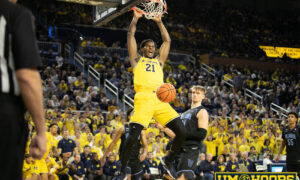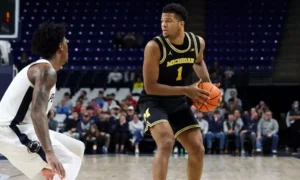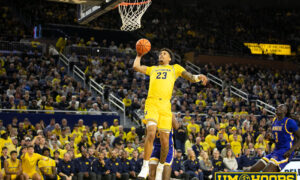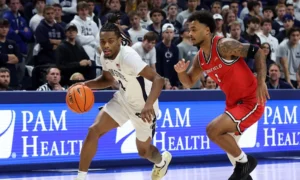Similarity Scores Explained. Previously: Caris LeVert
Derrick Walton faced an unenviable task in his first season at Michigan: replacing consensus national player of the year Trey Burke, one of the best players in program history. No one expected him to be able to fill in with Burke’s production immediately (and fortunately for Michigan, Nik Stauskas’s ascension into an all-around offensive threat and potential lottery pick mitigated the decline at point guard), but Walton acquitted himself very well in his first year on campus.
Though Walton was listed as a point guard, frequently handled the ball and often initiated Michigan’s offense, most of his comparable players are shooting guards. D.J. Byrd, Trent Meacham, Matt Gatens, Chris Allen, Caris LeVert, D.J. Richardson, Josh Gasser, and Blake Hoffarber (before a midseason injury to Al Nolen forced him to run the point) played off the ball for their respective teams. Compared to the above list, Walton had a pretty good assist rate, but there’s a lot to suggest that he was the functional equivalent of a wing player. His shooting line is remarkably similar to Caris LeVert’s (45 2P% / 41 3P% / 79 FT% for Walton to LeVert’s 46 / 41 / 77), but more to the point, their assist rates were also quite similar (19.8 to 17.2). Their rebounding numbers were close as well. Michigan’s customarily stellar ball movement still generated a fair number assists, but unlike in 2013, they came from a variety of sources. Walton led the team in assist rate, but not by much, and assists were pretty much evenly distributed by the three primary backcourt options – Derrick Walton, Caris LeVert, and Nik Stauskas.

The chart below has the assist distribution of Michigan’s offense compared to the best Big Ten offenses of each of the last seven years.

Perhaps it’s best to consider Walton’s game in the framework of this dynamic: Michigan didn’t really have a point guard. Traditional positions are becoming a bit blurred across basketball, and Michigan’s no exception – consider the bruising post-scoring and dominant rebounding power forward archetype and then remember that Michigan played with Zack Novak at the four for the better part of his career. Each of Walton, LeVert and Stauskas initiated offense, they all operated in the pick-and-roll with Michigan’s post players, they each spent possessions spotting up on the three-point line, and they all had drive-and-kick creative abilities that provided Michigan with its bevy of open three-pointers. Walton was the smallest of the three and guarded opposing point guards, but beyond that, there wasn’t much to distinguish him from LeVert and Stauskas, positionally speaking. After a year of Darius Morris (and his astronomical assist rate and massive burden as the offensive catalyst) and two of Trey Burke (who had the ball in his hands almost all the time, for good reason), it was a big change. If Walton’s position had to be defined, it would be hard to classify him as a true point guard.
The shooting guards on the list are some nice comparisons for Walton. D.J. Byrd’s senior year went poorly at Purdue, but he was a pretty good role player on that team; Trent Meacham was an efficient three-point specialist over half a decade ago for Illinois; Gatens’ freshman year makes another appearance, and Michigan would probably take a Gatens-like career out of Walton; Chris Allen’s ill-fated last season at Michigan State makes an appearance (though he was a solid player before getting kicked off of the team); Caris LeVert is obviously a favorable comparison, but besides usage, they were actually sort of close statistically; D.J. Richardson’s freshman year was much, much less efficient than Walton’s, but there were some similarities; Josh Gasser needs no introduction for Michigan fans after the fluky dagger he hit in Ann Arbor a few years back, and he differs from Walton in a lot of ways (namely his much lower usage and much higher efficiency); and Blake Hoffarber is another senior, who, like Byrd, carved out a valuable niche on his team. Stylistically, Walton doesn’t compare to a lot of those guys, but the numbers are quite similar and suggest that he’s perhaps more of a wing player than a true point.
The two point guards on the list are interesting. Indiana’s Yogi Ferrell and Northwestern’s Dave Sobolewski and their freshmen seasons were somewhat similar to Walton’s – the key differences being that Ferrell shot more poorly and Sobolewski had a way lower level of usage. Since logging those seasons, the trajectories of each career were much different: Ferrell ratcheted up his usage while becoming a much better shooter and Sobolewski has since been almost effectively pulled out of Northwestern’s rotation because of poor play. Ferrell has a breakout sophomore season and would be an aspirational goal for Walton next year (though Walton will have much more shooting and scoring options around him than Ferrell did), but it’s something to watch.
Alex Cook, the author of this post, can be found on Twitter @alexcook616. Any comparison requests are more than welcome.









